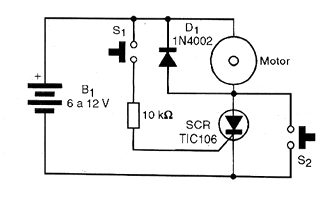With a touch of switch S1 the motor starts and remains so until a touch of switch S2 turns it off. The circuit shown in the figure can be used in many important robotics and mechatronics applications. As switches S1 and S2 can be sensors, such as reed-switches, limit switches and other sensors, the applications are unlimited. Just press a switch for example, and a conveyor moves until it carries an object to its end. At the end, sensor S2 is activated and the belt stops automatically. The SCR does not need a heat radiator for engines up to 500 mA. Above that, it will be convenient to use a small metal flat iron for this purpose. The D1 diode serves as a filter to prevent pulses of transients generated when switching the motor coils from appearing over the SCR causing it to shut down at an inappropriate time. If there is a tendency to switch off even with the diode, an electrolytic capacitor from 100 uF to 1 000 uF must also be connected in parallel with this component. An important point to note in this circuit is that there is a voltage drop of around 2 volts in a connected SCR. This means that the supply voltage must be 2 V greater than that required by the motor to compensate for this loss. It is for this reason that the suggested minimum input voltage for these circuits is 6 volts.




